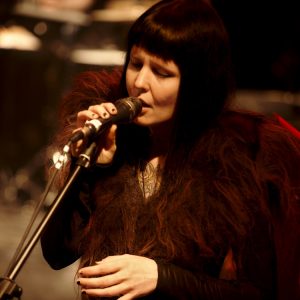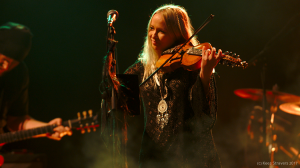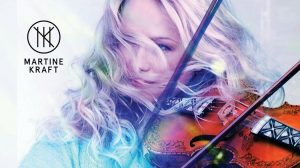Here is our (belated ?) present: a review of Omphalos by Cliff!
As most of you will know,
Fieke van den Hurk
left Cesair last year to focus on her career as a producer and sound engineer at her
Dearworld studio
. The band was extended with new, but well-experienced band-members
Luka Aubri
(RASTABAN) and
Faber Auroch
(
Sowulo
).
With this change, there was no way around it… the big question with
Cesair
‘s second album was: “How would they sound with their new line-up?”. The pre-CD-release concert at
Castlefest
2017 sounded very promising. Visually the band was as entertaining as ever.
But what about the album? Well…
Read all about it in
Cliff’s latest review
! 😉
Tag Archives: Cliff
Happy birthday to Jan de Vries of Cesair! ?
- 14 Jan
- Helen van der Jagt
- 0 Comments
Cesair – Omphalos (2017)
- 26 Dec
- celtadmin
- 0 Comments
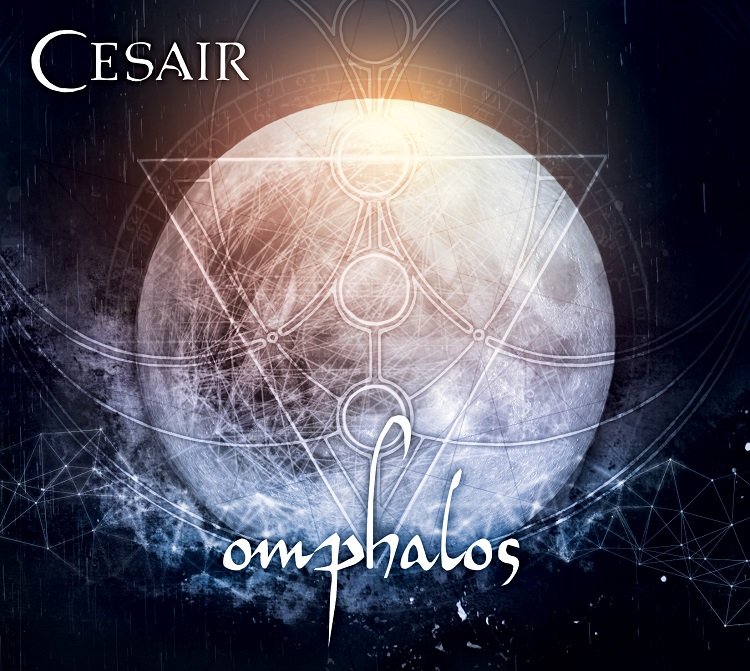
Cesair is a six-person band that blends Classical together with Pop (World) music, giving it a nice Eastern-European feel as they go along. Together, this makes for a unique sounding band. Cesair themselves describe their sound as ‘Epic Folk and Mythic music´. I would say Carl Orf meets Vivaldi meets Rastaban meets Faun equals Cesair. They are one of the few bands that really manage to marry Classical skills with Pop music and get away with it.
With Dies, Nox et Omnia Fieke, as a producer, recorder, editor and mixer, gave Cesair a real powerful sound. Just as Carl Orf‘s Carmina Burana blows you away with the bold sounds of a big orchestra playing at full strength, Cesair managed to do the same. The accordion and hurdy-gurdy themselves are already instruments that can fill a room and Fieke made good use of the surround sound to give the whole band a overpowering impact. Hearing the main instruments in front of you, but nice bouzouki and violin accents coming from all sides. Just listen to Cansa and you’ll hear the violin playing in the corner of your ear. Or Graeica where Thomas’ bouzouki is placed in the same way that gave Dies, Nox et Omnia a really big orchestral sound.
As most of you will know, Fieke van den Hurk left the band last year to focus on her career as a producer and sound engineer at her Dearworld studio. The band was extended with new, but well-experienced band-members Luka Aubri (Rastaban) and Faber Auroch (Sowulo). With this change, there was no way around it… the big question with Cesair‘s second album was: “How would they sound with their new line-up?”. The pre-CD-release concert at Castlefest 2017 sounded very promising. Visually the band was as entertaining as ever. During the concert there was even that bit of ‘Fieke magic’, with her standing in the audience and singer Monique van Deursen and Violinist Sophie Zaaijer goofing with her from off the stage.
But what about the album? Well, Fieke is still part of the band on Omphalos!
Although saying her formal goodbyes to the audience on stage in March of 2017, with a wonderful concert in the Peppel in Zeist, the band decided Fieke was so involved writing the Omphalos songs that she still deserved to be named as a band-member in the credits, next to new members Luka and Faber.
Therefore she says her official goodbyes to us, the fans, with the album Omphalos. A fitting and touching tribute to Fieke from the band, showing how beautiful a friendship in music can be.
Onto Omphalos.
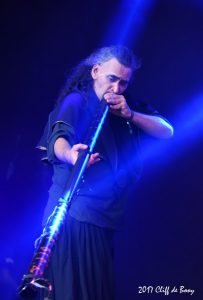 With this album the band went a different route. This time the mix is more open. Fieke, also producing, recording and mixing this album, plays with the volume in stead of putting up this impressive wall of sound. Listening you can discover little pearls. Lead soloists are pushed forward and supporting instruments are less pronounced in the mix, leading your ear through the music. New band-members Luka and Faber fit well within the music.
With this album the band went a different route. This time the mix is more open. Fieke, also producing, recording and mixing this album, plays with the volume in stead of putting up this impressive wall of sound. Listening you can discover little pearls. Lead soloists are pushed forward and supporting instruments are less pronounced in the mix, leading your ear through the music. New band-members Luka and Faber fit well within the music.
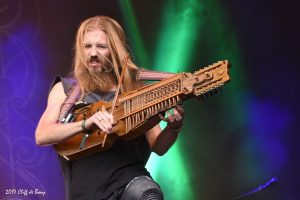 Fieke took on a more supporting role which made room for my personal highlight on
Omphalos:
the string section. Both Sophie and Faber play wonderful string melodies. Their solos and melody lines really take the lead role together with Monique’s voice. While
Dies, Nox et Omnia
focuses on the band as a unit, with
Omphalos
the talents of each individual musician comes out. And they are talented! Monique has a wonderfully pure and powerful, classically trained voice with an impressive range. One of the strong-points of Cesair. In this more open sound Thomas Biesmeijer really gets the chance to colour the music with his guitar and bouzouki chords. This new sound also means Jan de Vries can shine more as a percussionist. His drums don’t disappear in the overall sound, but are a main feature. Just listen to him drive to music on
Troll Kala Mik.
Fieke took on a more supporting role which made room for my personal highlight on
Omphalos:
the string section. Both Sophie and Faber play wonderful string melodies. Their solos and melody lines really take the lead role together with Monique’s voice. While
Dies, Nox et Omnia
focuses on the band as a unit, with
Omphalos
the talents of each individual musician comes out. And they are talented! Monique has a wonderfully pure and powerful, classically trained voice with an impressive range. One of the strong-points of Cesair. In this more open sound Thomas Biesmeijer really gets the chance to colour the music with his guitar and bouzouki chords. This new sound also means Jan de Vries can shine more as a percussionist. His drums don’t disappear in the overall sound, but are a main feature. Just listen to him drive to music on
Troll Kala Mik.
 With
Dies, Nox et Omnia
Cesair took us on a journey through classic texts and history. Quoting and interpreting passages of Babylonian, medieval Dutch, 7th century Greek and 16th century Spanish texts to name a few.
With
Dies, Nox et Omnia
Cesair took us on a journey through classic texts and history. Quoting and interpreting passages of Babylonian, medieval Dutch, 7th century Greek and 16th century Spanish texts to name a few.
On Omphalos, Monique takes us with her on a similar journey through old and modern literature. The inspiration while writing this album came from the Roman poet Quintus Horatius Flaccus (a.k.a. Horace), the Spanish poet Federico García Lorca, the Romanian poet George Coșbuc, some anonymous sources and the poetic Edda, an anonymous collection of Icelandic medieval poems.
As always I don’t want to go through all the songs on the CD. It’s way more fun to discover the music yourself without me spoiling everything. But still, here are some I really wanted to high-light.
 Erda,
the first track of the album: a first class earworm. Straight away, the more open sound of this album works it’s magic. Monique and Sophie shine in this song. As said, Monique is such a skilled mezzo-soprano, she impresses throughout the whole album, as does Sophie. Hearing her taking the lead solo so clearly and often, I suddenly realise how amazing she is as a violinist. Stunning.
In all, if you listen to
Erda
and like it, you can safely buy the whole album. The song is a perfect representation of Cesair anno 2017.
Erda,
the first track of the album: a first class earworm. Straight away, the more open sound of this album works it’s magic. Monique and Sophie shine in this song. As said, Monique is such a skilled mezzo-soprano, she impresses throughout the whole album, as does Sophie. Hearing her taking the lead solo so clearly and often, I suddenly realise how amazing she is as a violinist. Stunning.
In all, if you listen to
Erda
and like it, you can safely buy the whole album. The song is a perfect representation of Cesair anno 2017.
Many of you will already know Chorihani from various concerts: a cheerful, fast song with, again, a beautiful solo from Sophie, this time straight from a gipsy party it seems. Good old Fieke and her accordion make it even more Eastern-European.
Troll Kala Mik
 we also know from the Cesair concerts. It´s a duet (or is it a duel?) between the beautiful poet Monique and the ugly troll Thomas. Pick your own favourite, but mine would be… …Jan. His percussion work is the foundation of this song. You could even say he plays the lead instrument on this.
we also know from the Cesair concerts. It´s a duet (or is it a duel?) between the beautiful poet Monique and the ugly troll Thomas. Pick your own favourite, but mine would be… …Jan. His percussion work is the foundation of this song. You could even say he plays the lead instrument on this.
Another duet is Ahes. It’s Cesair’s interpretation of a medieval love story from Brittany. It tells of a forbidden love between princess Ahes (a.k.a. Dahut) and a lover she invited in, before being married. A great sin in medieval times. Of course the whole city was punished and swallowed by the sea, as would happen in old times. Faun‘s Stephan Groth takes on the role of the lover from the ocean, who persuades Ahes to open the gates of her city. A guest appearance to look forward to should Faun and Cesair play the same MPS festivals the coming season.
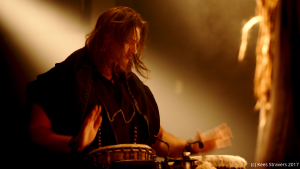
Mardochaios is the Greek name for the Mesopotamian god Marduk. The song is an anthem for him, again driven by the powerful drums of Jan, followed by some beautiful violin melodies and vocals. My personal favourite song of the album.
Yet another song that has an interesting musical feel is Boudicca. The intro with the strong, almost threatening, male/female vocals make it sound like an menacing Enya or Clannad on their very best days. Sophie´s violin solo pulls you straight back into the Cesair world but the song keeps that eerie feel to it… A real tribute to the lady who dared to defy the Romans.
As i said, I could name all the songs because they all are equally good. Omphalos is an album that you need to get if you love an impressive mix of classical and folk/world music. It’s an album that will mesmerize you, make you want to play it again and again. One piece of advice: play it loud and get the whole impact of the album. It’s going to be worth it. At full volume is where the true beauty of Omphalos appears in all its glory… or live on stage of course!!
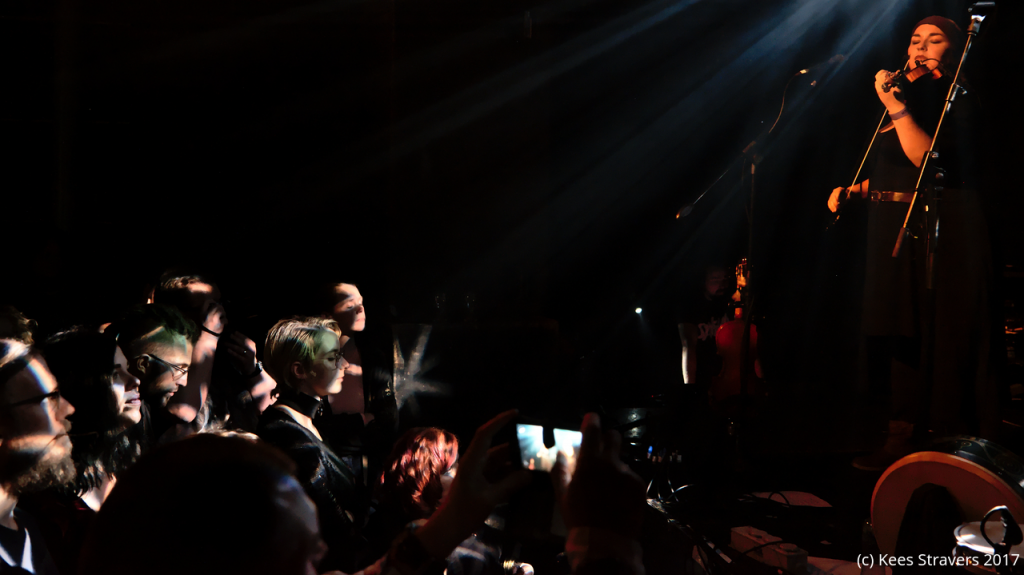
– Cliff
– Pictures 1, 3, 4 and 7 taken at Castlefest 2017 and picture 2 taken at the Gothic & Fantasy Beurs 2013,
courtesy of: Cliff de Booy
– Pictures 5, 6, 8 and 9 taken at the Omphalos release party at the Willemijn, Almere 02-12-2017,
courtesy of: Kees Stravers
Helisir – Spin (2017)
- 26 Oct
- celtadmin
- 0 Comments
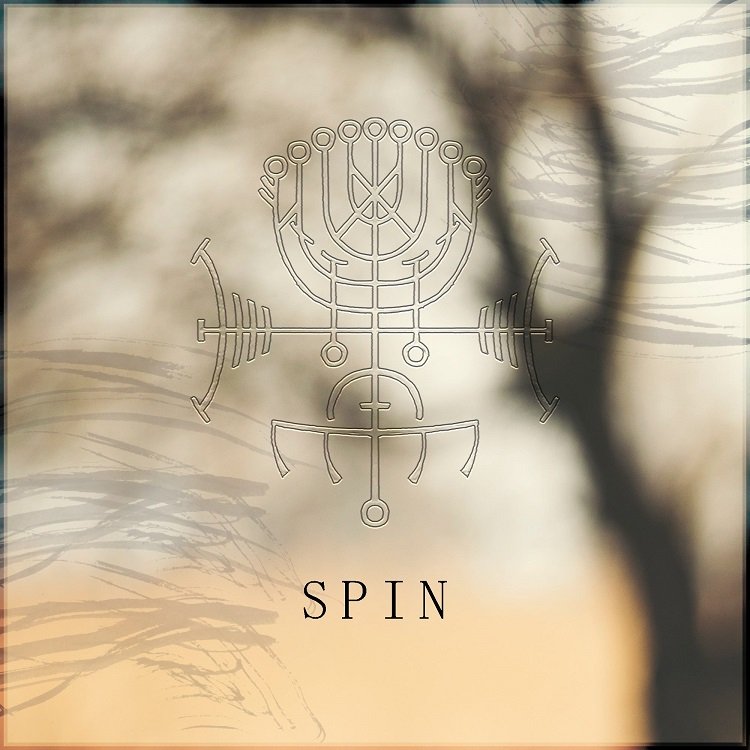
The latest (and last) Helisir CD ‘SPIN’ came out this September and it’s a gem!
But first let’s introduce Helisir a bit more.
Helisir is the musical project and brainchild of Jacqueline Stempher. It started out as an idea for a book based around the fictive Nordic land Helisir, a Nordic equivalent of Avalon where the old Gods in ancient times met.
Over time their stories were set into music by Jacqueline and they ended up on the first Helisir album ‘Ravn’. It was produced by Jacqueline herself and could best be described as Nordic influenced ambient Pagan music. All instruments recorded were played by Jacqueline herself.
In 2016, a mini CD came out called ‘Sårbare’. It was recorded at the Dear World studio by Fieke van der Hurk and featured Jacqueline on harp and vocals in an all acoustic setting.
Now the third album ‘SPIN’ is finally here to conclude the Helisir story.
This time Jacqueline visited the Lava Studios in Copenhagen to have Christopher Juul record ‘SPIN’. The album picks up on the sound of ‘Ravn’ and is musically best described as a crossover between Dido and Euzen. (So not the voice/harp sound we have come to know through her ‘live ploink‘ streaming concerts on Facebook or the mini CD ‘Sårbare’.)
Jacqueline’s last
Facebook livestream
from the Netherlands, just before moving up North.
From the first seconds of ‘The Tide’ it’s clear this album is all about Jacqueline’s beautiful voice. A crossover between the laid back, fragile way of singing of Dido, the strong sound of Anneke van Giersbergen (ex-The Gathering, Ayreon) and a touch of Sara Weeda (SeeD, ANÚNA).
In her lyrics Jacqueline stayed close to her heart, making this her most personal album. She has put the feelings and fears she went through the past years in beautiful musical poems, partly in English, but also some in Dutch. Listen to ‘Done’, ‘Lighthouse’, ‘Ashes’ or the Dutch title song ‘Spin’ and you’ll hear how personal her lyrics have become.
Jacqueline composed all the music and Christopher Juul arranged all the songs and took care of the instruments, so Jacqueline could focus on the vocals. He managed to make the music work as a supportive partner to Jacqueline’s voice, enhancing the lyrics instead of the instruments taking over. Those who love Euzen will recognize his style with those subtle touches making the music interesting and ‘SPIN’ a CD well worth buying!
I am now left with two wishes:
1. That somewhere in the future, Jacqueline will team up again with Christopher to make more music. It would be such a shame if that would never happen again.
and
2. That Castlefest will book Euzen for their Winter Edition 2017 and they will ask them to support Jacqueline Stempher there on stage as well, so we can hear her songs live in the way they were intended to sound. Mark… Jacqueline… Christopher… pretty please??? 🙂
– Cliff
– Live concert pictures courtesy of:
Kees Stravers
https://www.flickr.com/photos/case_s
ALBUM REVIEW: Martine Kraft – Huldreblod!
- 08 Oct
- Helen van der Jagt
- 0 Comments
A little over a week ago we introduced
Cliff
to you all as our latest CeltCast family member, and one of the things he said he would be doing for us is reviewing albums, so it’s time for the first one!
Having Martine Kraft ‘s amazing song “Himmelfot” as our Monthly Marker this month, we thought it would be a good idea to start with a review of the album this song is from, Huldreblot, which was released last May.
In his review Cliff certainly shows what he’s made of, as he delves deep into not only the amazing album that it is, but also into his emotional connections with other music that was triggered by it and he clearly did research to provide the reader with not only relevant but also very interesting background information!
Curious yet? Good! 😀
Head on over to this link and read the review! You won’t be disappointed!
Having Martine Kraft ‘s amazing song “Himmelfot” as our Monthly Marker this month, we thought it would be a good idea to start with a review of the album this song is from, Huldreblot, which was released last May.
In his review Cliff certainly shows what he’s made of, as he delves deep into not only the amazing album that it is, but also into his emotional connections with other music that was triggered by it and he clearly did research to provide the reader with not only relevant but also very interesting background information!
Curious yet? Good! 😀
Head on over to this link and read the review! You won’t be disappointed!
Martine Kraft – Huldreblod (2017)
- 07 Oct
- celtadmin
- 0 Comments

Alex and I both have our guilty pleasures. Bands that don’t fit the CeltCast format, but we like anyway. (I have quite a lot actually, but that’s beside the point.) 😉
One of those guilty pleasures we share together, is Martine Kraft‘s newest album ‘Huldreblod’. It made a big impression on us both. As did her performance at Castlefest, together with Kati Ran. So it’s no surprise one of her songs is the CeltCast Monthly Marker for October. And with that we can also introduce her and her music to the CeltCast community. With pleasure. 🙂
Martine Kraft (34) is a Norwegian musician, singer and composer. Her main instrument is the Hardanger fiddle (in Norse: Hardingfele), which is called the Norwegian national instrument and is named after the area it originates from, Hardanger. The first known one was made in 1615. The Hardanger fiddle is quite similar to a ‘normal’ violin with 4 strings that are played with a bow, but under the 4 strings are another 4 or 6 which are lead through the bridge under the ‘main’ strings and which resonate with the upper strings.
Traditionally the Hardanger fiddle is richly decorated with carvings, Mother of Pearl inlays and black ink decorations called Rosing. Martine’s personal Hardanger fiddle, called ‘Huldrefela’, was given to her by the Norwegian Hardanger fiddle fund, in recognition of her work to make this fiddle more widely known. It’s a 10 string Hardanger fiddle with a special tuning mechanism, making it easier to tune while on the road in challenging climates. It was made by the master violin maker Helge M. Bergnord.
Martine also plays the nyckelharpa (a keyed fiddle and the Swedish national instrument), the ‘ordinary’ violin and the viola (or Bratsj as the Norwegians call it), which is a bigger violin with a deeper sound. Beside the violins she also plays several kinds of flutes. On stage as well as on her album, she is accompanied by her Martine Kraft band consisting of her life partner Nils Jørgen Nygaard Kraft on guitar and keyboards (among other things), Stig Enger on electric guitar, Jon Karlsen on bass and Freddy Wike on drums.
Her fifth album ‘Huldreblod’ was recorded in the Enger studio with Stig. He also co-produced the CD together with Nils Jørgen. Martine wrote all the music for the album and almost all the lyrics. Nils Jørgen wrote them for the tracks ‘Huldreblod’ and ‘Himmelfot’.
Track 1: Huldreblod
On the opening track of the CD, the title track ‘Huldreblod’, Martine showcases that Hardanger fiddle straight away. Huldreblod is a song about the forest nymph ‘Huldra’, a nymph that fell in love with a human. To be able to be with her lover she lost her abilities as a nymph. Every time she was treated wrong, she lost a little bit of her beauty, but her strength and wisdom stayed with her. In a touching and real personal way, Martine dedicates this whole album to Huldra and the strength we all carry inside. We all can have a bit of Huldra running through our veins. The song itself starts with the sound of a Rhombus, (Norse: Brummar) and whispered Norse lyrics, giving us the eerie feel of the dark, misty Norwegian forests where Huldra once lived. The Hardanger fiddle comes in for a fast, ear-catching Prog-rock song. The way the song is built up: the choir, the church organ, the sound of the guitar solo, the break with organ… makes me think of Mike Oldfield’s early work. And I mean that in a real complimentary way. This song grabs you and drags you into the album, leaving you with a ear-worm that will stick with you for days. 🙂
Track 2: Sølje
The second song, ‘Sølje’, is a ballad. A Sølje is a piece of Nordic jewellery, in this case left by Huldra on a path for a young man to be found. Here we hear Martine’s voice for the first time and it is a unique one. High, a wee wee bit hoarse and very young in tone, delicate and fragile, which fits the music really well. Martine uses her voice in the same way as Ágnes Tóth (The Moon and the Night Spirit), to enhance the feel of the music she makes. It starts out really gently with only piano, showing her music is about the songs. Not a violin extravaganza. The violin only comes in on the second part of the song with a powerful musical break, kicking this into a pure power-ballad.
Track 3: Frikar
‘Frikar’ starts out with a keyboard intro that, very shortly, reminds me a bit of Euzen. It’s a pure Prog-rock intro actually, but then the violin steps in and the music takes a 180° turn into a pure up-tempo Folk song. A tribute to the toughest Norwegian traditional dancers, the Frikar.
Track 4: Villvind
Next ‘Villvind’ starts with a jazzy, jumpy piano intro?! By now it’s getting clear that Martine’s music isn’t straight forward. She likes to tease us listeners, keep us surprised, putting us on the wrong foot, while the music stays catchy and fun at the same time. Impressive. The song goes on as an instrumental, bit jazzy violin improvisation (or at least it feels like that) again within that Prog-rock style. Especially when the music builds up beautifully from a real gentle, fragile violin improvisation into a climax, lead by Stig Enger’s electric guitar. Short, but oh so powerful (and my head suddenly goes ‘Hello, Dream Theater‘). At this point it’s also clear that the whole band excels on this album. Just listen to Jon Karlsen’s bass-line on ‘Villvind’.
Track 5: Nar dagen hviler
‘Nar dagen hviler’ is a second ballad. Starting with a moving, Gypsy like violin solo and Martine’s special fragile voice we are drifting away in moon filled dreams. An ambient, dream-scape kinda song.
Track 6: Himmelfot
Which brings us to our Monthly Marker, ‘Himmelfot’. Here I quote Martine from the introduction she wrote in the booklet: ”My child was born with a birthmark shaped like a cloud on his foot. This song ‘Himmelfot’ means ‘sky foot’ “. The song starts with the sound of child’s play, and a balladesque intro… but then jumps into a cool cheerful ‘Norwegian’ jig. Bring out the Balfolk dancers!
Track 7: Solefall
‘Solefall’ is a nice mid-tempo Prog-rock song featuring the violin again. With a nice vocal display from Martine to top it off.
Track 8: Mørketid
‘Mørketid’ is a beautiful ballad. It is one of the more personal songs on ‘Huldreblod’ for Martine, judging by her intro in the booklet. And you can hear it. Just read her intro in the booklet and flow with the music. A special mention to the male ‘Joik’ * on this track. Just another part of the musical diversity of this band proving how they are able to blend Norse (Nordic) traditions into modern songs.
Track 9: Djeveldans
&
Track 10: Nidhogg
‘Djeveldans’ and ‘Nidhogg’ are up-tempo instrumental Prog-rock songs again. Beautiful, with the violin taking over the role of the electric guitar solo’s. Keeping the sound really clean yet powerful. All kind of musical twists are in there again, as it should be in progressive music. Piano, choirs, breaks… it is all there. Special mention in this case to drummer Freddy Wike in ‘Nidhogg’. He gets his chance to shine with some impressive double bass drumming. Oh and did I mention the trombone in this song already?!?
Track 11: Ravn
After all this pure energy, the album ends with the ambient ballad ‘Ravn’. Again, in the booklet, Martine gets real personal in her message to us, the listener. Sharing with us her wishes for future times. Again you can hear it in the music. ‘Ravn’ becomes a beautiful ending to ‘Huldreblod’. An album I really fell in love with during the listening-sessions for this introduction.
If the idea of a unique mix of progressive Pop/Rock music, with a Hardanger fiddle as lead solo instrument (in stead of screamin’ guitars or keyboards), dipped way deep in Norwegian traditions and folklore appeals to you, then this is your CD. If in doubt, just check out our Monthly Marker ‘Himmelfot’ and be convinced. In the meantime I’m gonna go after the other four Martine Kraft albums. This one made me hungry for more! 🙂
– Cliff
* the Joik is one of the traditional ways of singing of the Sami people. As an art form, each Joik is meant to reflect or evoke a person, animal or place. Music researchers believe that the Joik is one of the longest-living musical traditions in Europe. (all according to Wikipedia)
– Live concert pictures courtesy of:
Kees Stravers
https://www.flickr.com/photos/case_s

